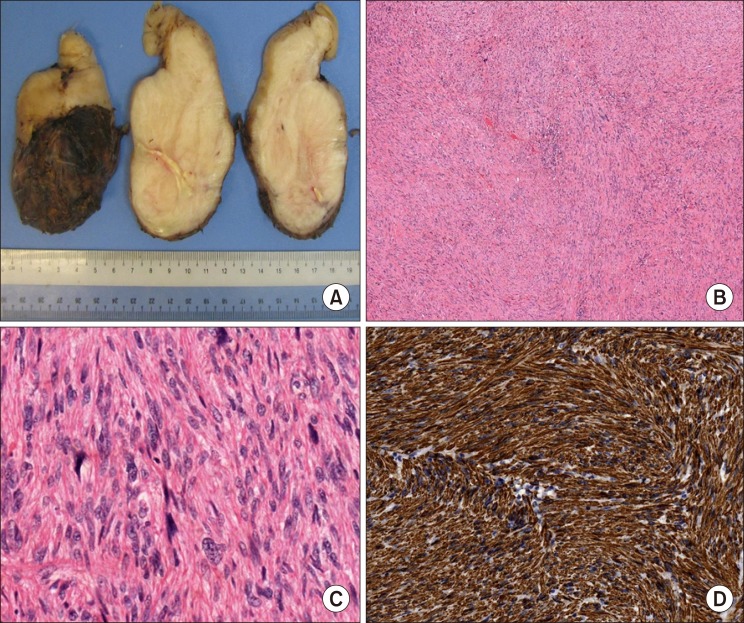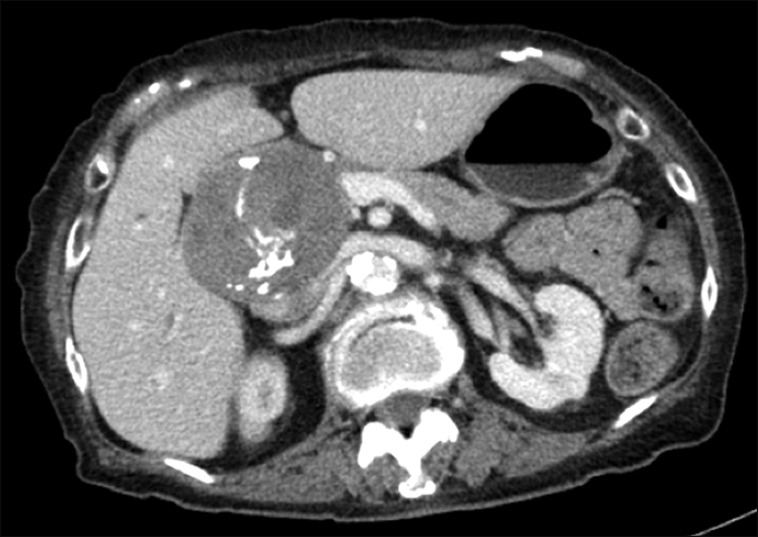1. Kwon TW, Sung KB, Cho YP, Kim DK, Yang SM, Ro JY, et al. Pararenal leiomyosarcoma of the inferior vena cava. J Korean Med Sci. 2003; 18:355–359. PMID:
12808321.

2. Hollenbeck ST, Grobmyer SR, Kent KC, Brennan MF. Surgical treatment and outcomes of patients with primary inferior vena cava leiomyosarcoma. J Am Coll Surg. 2003; 197:575–579. PMID:
14522326.

3. Laskin WB, Fanburg-Smith JC, Burke AP, Kraszewska E, Fetsch JF, Miettinen M. Leiomyosarcoma of the inferior vena cava: clinicopathologic study of 40 cases. Am J Surg Pathol. 2010; 34:873–881. PMID:
20463568.

4. Mingoli A, Cavallaro A, Sapienza P, Di Marzo L, Feldhaus RJ, Cavallari N. International registry of inferior vena cava leiomyosarcoma: analysis of a world series on 218 patients. Anticancer Res. 1996; 16:3201–3205. PMID:
8920790.
5. Wachtel H, Gupta M, Bartlett EK, Jackson BM, Kelz RR, Karakousis GC, et al. Outcomes after resection of leiomyosarcomas of the inferior vena cava: a pooled data analysis of 377 cases. Surg Oncol. 2015; 24:21–27. PMID:
25433957.

6. Spinelli A, Schumacher G, Benckert C, Sauer IM, Schmeding M, Glanemann M, et al. Surgical treatment of a leiomyosarcoma of the inferior vena cava involving the hepatic and renal veins confluences: technical aspects. Eur J Surg Oncol. 2008; 34:831–835. PMID:
17321715.

7. Kevorkian J, Cento DP. Leiomyosarcoma of large arteries and veins. Surgery. 1973; 73:390–400. PMID:
4687797.
8. Kulaylat MN, Karakousis CP, Doerr RJ, Karamanoukian HL, O'Brien J, Peer R. Leiomyosarcoma of the inferior vena cava: a clinicopathologic review and report of three cases. J Surg Oncol. 1997; 65:205–217. PMID:
9236931.

9. Dzsinich C, Gloviczki P, van Heerden JA, Nagorney DM, Pairolero PC, Johnson CM, et al. Primary venous leiomyosarcoma: a rare but lethal disease. J Vasc Surg. 1992; 15:595–603. PMID:
1560548.

10. Liu C, Zheng Y, Yang X, Shao J, Song X, Liu B, et al. Surgical resection of the inferior vena cava for leiomyosarcoma. Ann Vasc Surg. 2010; 24:822.e11–822.e15.

11. Mingoli A, Feldhaus RJ, Cavallaro A, Stipa S. Leiomyosarcoma of the inferior vena cava: analysis and search of world literature on 141 patients and report of three new cases. J Vasc Surg. 1991; 14:688–699. PMID:
1942380.

12. Monteagudo Cortecero J, Guirau Rubio MD, Payá Romá A. Leiomyosarcoma of the inferior vena cava: AIRP best cases in radiologic-pathologic correlation. Radiographics. 2015; 35:616–620. PMID:
25763742.
13. Alkhalili E, Greenbaum A, Langsfeld M, Marek J, Rana MA, Glew R, et al. Leiomyosarcoma of the inferior vena cava: a case series and review of the literature. Ann Vasc Surg. 2016; 33:245–251. PMID:
26802297.
14. Hines OJ, Nelson S, Quinones-Baldrich WJ, Eilber FR. Leiomyosarcoma of the inferior vena cava: prognosis and comparison with leiomyosarcoma of other anatomic sites. Cancer. 1999; 85:1077–1083. PMID:
10091791.
15. Teixeira FJR Jr, do Couto Netto SD, Perina ALF, Torricelli FCM, Ragazzo Teixeira L, Zerati AE, et al. Leiomyosarcoma of the inferior vena cava: survival rate following radical resection. Oncol Lett. 2017; 14:3909–3916. PMID:
29098019.

16. Ito H, Hornick JL, Bertagnolli MM, George S, Morgan JA, Baldini EH, et al. Leiomyosarcoma of the inferior vena cava: survival after aggressive management. Ann Surg Oncol. 2007; 14:3534–3541. PMID:
17896156.






 PDF
PDF ePub
ePub Citation
Citation Print
Print



 XML Download
XML Download